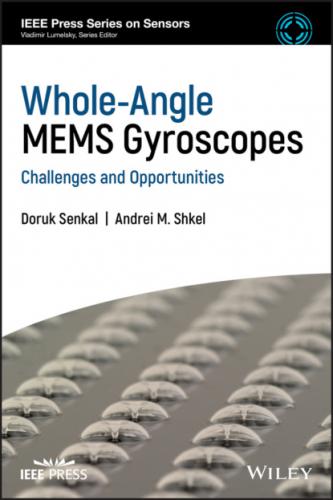About the Authors
Doruk Senkal
Dr. Senkal has been working on the development of Inertial Navigation Technologies for Augmented and Virtual Reality applications at Facebook since 2018. Before joining Facebook, he was working as a MEMS designer at TDK Invensense, developing MEMS Inertial Sensors for mobile devices.
He received his PhD degree (2015) in Mechanical and Aerospace Engineering from the University of California, Irvine, with a focus on MEMS Coriolis Vibratory Gyroscopes, received his MSc degree (2009) in Mechanical Engineering from Washington State University with a focus on robotics, and received his BSc degree (2007) in Mechanical Engineering from Middle East Technical University.
His research interests, represented in over 20 international conference papers, 9 peer‐reviewed journal papers, and 16 patent applications, encompass all aspects of MEMS inertial sensor development, including sensor design, device fabrication, algorithms, and control.
Andrei M. Shkel
Prof. Shkel has been on faculty at the University of California, Irvine, since 2000. From 2009 to 2013, he was on leave from academia serving as a Program Manager in the Microsystems Technology Office of DARPA, where he initiated and managed over $200M investment portfolio in technology development. His research interests are reflected in over 250 publications, 40 patents, and 3 books. Dr. Shkel has been on a number of editorial boards, most recently as Editor of IEEE JMEMS and the founding chair of the IEEE Inertial Sensors (INERTIAL). He has been awarded in 2013 the Office of the Secretary of Defense Medal for Exceptional Public Service, 2020 Innovator of the Year Award, 2009 IEEE Sensors Council Technical Achievement Award, 2008 Researcher of the Year Award, and the 2005 NSF CAREER award. He received his Diploma with excellence (1991) in Mechanics and Mathematics from Moscow State University, PhD degree (1997) in Mechanical Engineering from the University of Wisconsin at Madison, and completed his postdoc (1999) at UC Berkeley. Dr. Shkel is the 2020–2022 President of the IEEE Sensors Council and the IEEE Fellow.
1 Introduction
Coriolis Vibratory Gyroscopes (CVGs) are mechanical transducers that detect angular rotation around a particular axis. In its most fundamental form, a CVG consists of two or more mechanically coupled vibratory modes, a forcing system to induce vibratory motion and a sensing system to detect vibratory motion. Angular rotation can be detected by sensing the energy transfer from one vibratory mode to another in the presense of Coriolis forces, Figure 1.1.
Historically, first examples of CVGs can be found in the Aerospace Industry, which were primarily used for navigation and platform stabilization applications. Later, advent of Micro‐electromechanical System (MEMS) fabrication techniques brought along orders of magnitude reduction in cost, size, weight, and power (CSWaP), which made CVGs truly ubiquitous. Today CVGs are used in a wide variety of civilian applications, examples include:
Industrial applications, such as robotics and automation;
Automobile stabilization, traction control, and roll‐over detection;
Gesture recognition and localization in gaming and mobile devices;
Optical image stabilization (OIS) of cameras;
Head tracking in Augmented Reality (AR) and Virtual Reality (VR);
Autonomous vehicles, such as self‐driving cars and Unmanned Aerial Vehicles (UAVs).
1.1 Types of Coriolis Vibratory Gyroscopes
CVGs can be divided into two broad categories based on the gyroscope's mechanical element [1]: degenerate mode (i.e.
Figure 1.1 Coriolis Vibratory Gyroscopes, in their simplest form, consist of a vibrating element with two or more mechanically coupled vibratory modes. Illustration shows a
1.1.1 Nondegenerate Mode Gyroscopes
Nondegenerate mode CVGs are currently being used in a variety of commercial applications due to ease of fabrication and lower cost. Most common implementations utilize two to four vibratory modes for sensing angular velocity along one to three axes. This is commonly achieved by forcing a proof mass structure into oscillation in a so‐called “drive” mode and sensing the oscillation on one or more “sense” modes. For example, the
Resonance frequency of sense modes are typically designed to be several hundreds to a few thousand hertzs away from the drive frequency. The existence of this so‐called drive‐sense separation (
